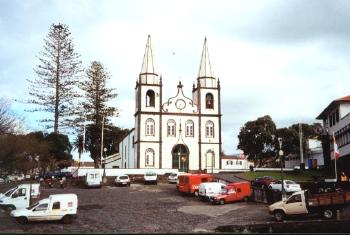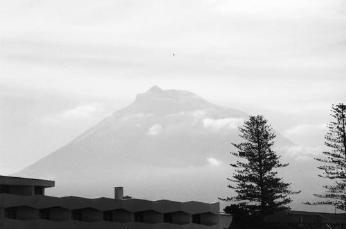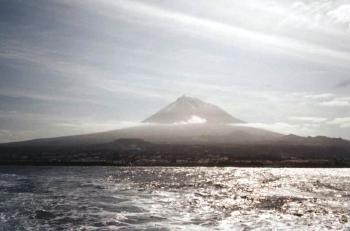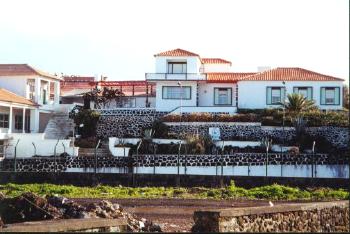Pico, The Azores (Açores), Portugal (March 2001)

Madalena, on Pico’s western coast, is the principal town on the island (map). It is also a vital transportation link to the island of Faial via ferry from the nearby municipal dock [see my Pico – Faial Ferry page].
The most impressive building in Madalena is undoubtedly the Church of Santa Maria Madalena. It dates to the 17th Century and was rebuilt in the 19th Century. We found a taxi stand just to the left of the church in this photograph. Here, drivers can be hired at reasonable rates for personalized guided tours of Pico. This was much better than simply renting a car on our own. Some of the drivers speak excellent English because they have connections to the Azores’ expatriate communities in Canada and the United States. And of course they know much more about Pico than any guidebook or map. Look for the signs in the taxi windows that denote English-speaking drivers.
Portuguese Highpoint

Everything on Pico is dominated by the huge volcano that created the island. Pico literally means “Peak” in Portuguese. So even the name of the island derives from this huge mountain. In fact it even registers as the highest point of elevation anywhere in Portugal. Here the summit rises 2,351 meters (7,713 feet) above the surrounding ocean.
We observed this particular view from Madalena harbor. However this is a typical backdrop everywhere on the island whenever the weather cooperates. Pico was the most dramatic and distinct of all the geographic features we observed during out visit to the Azores.
Memorable From Any Angle

Pico is equally impressive from a distance. We experienced this view from the sea while crossing to Faial. Madalena sits on a relatively flat coastal plain, seen in the foreground. It slopes gently up from the sea and allows easy access onto the island. Then, Pico the volcano, rises steeply behind it, the greatest summit of the Mid-Atlantic Ridge.
Architecture

Above is a residence located in Madalena. I included this photograph for a couple of reasons. First, it shows that there is a level of prosperity on the island. Second it demonstrates an interesting mixture of modern and traditional building techniques. The house is thoroughly modern. The terraced walls, in contrast are typically Pico: locally-sourced volcanic rock with starkly white mortar.
Articles in The Azores Series
- Index of All Islands Visited
- The Island of Pico

Leave a Reply